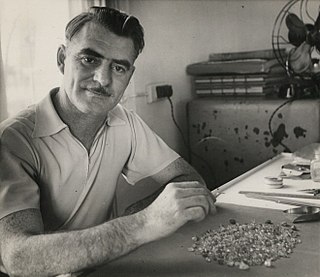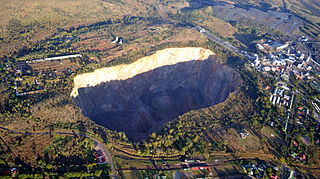
Diamond is a solid form of the element carbon with its atoms arranged in a crystal structure called diamond cubic. Another solid form of carbon known as graphite is the chemically stable form of carbon at room temperature and pressure, but diamond is metastable and converts to it at a negligible rate under those conditions. Diamond has the highest hardness and thermal conductivity of any natural material, properties that are used in major industrial applications such as cutting and polishing tools. They are also the reason that diamond anvil cells can subject materials to pressures found deep in the Earth.

The Cullinan Diamond is the largest gem-quality rough diamond ever found, weighing 3,106 carats (621.20 g), discovered at the Premier No.2 mine in Cullinan, South Africa, on 26 January 1905. It was named after Thomas Cullinan, the owner of the mine. In April 1905, it was put on sale in London, but despite considerable interest, it was still unsold after two years. In 1907, the Transvaal Colony government bought the Cullinan and Prime Minister Louis Botha presented it to Edward VII, the British king who reigned over the territory, and it was cut by Joseph Asscher & Co. in Amsterdam.

The Argyle Diamond Mine was a diamond mine located in the East Kimberley region in the remote north of Western Australia. Argyle was at times the largest diamond producer in the world by volume, although the proportion of gem-quality diamonds was low. It was the only known significant source of pink and red diamonds, and additionally provided a large proportion of other naturally coloured diamonds, including champagne, cognac and rare blue diamonds.

The Diavik Diamond Mine is a diamond mine in the North Slave Region of the Northwest Territories, Canada, about 300 km (190 mi) northeast of Yellowknife.
The Pink Star, formerly known as the Steinmetz Pink, is a diamond weighing 59.60 carats, rated in color as Fancy Vivid Pink by the Gemological Institute of America. The Pink Star was mined by De Beers in 1999 in South Africa, and weighed 132.5 carats in the rough. The Pink Star is the largest known diamond having been rated Vivid Pink. As a result of this exceptional rarity, the Beny Steinmetz Group called Steinmetz Diamonds took a cautious 20 months to cut the Pink. It was unveiled in Monaco on 29 May 2003 in a public ceremony.

The Williamson Diamond Mine is a diamond mine 23 kilometres (14 mi) northeast of Shinyanga in Tanzania; it became well known as the first significant diamond mine outside of South Africa. The kimberlite pipe was found in March 1940 and the mine established by John Williamson, a Canadian geologist, and has been continuous operation since then, making it one of the oldest continuously operating diamond mines in the world. Over its lifetime it has produced over 19 million carats (3,800 kg) of diamonds. A 2020 report by The Guardian said that high-quality pink diamonds from the mine could value up to $700,000 a carat.

John Thoburn Williamson was a Canadian geologist famous for establishing the Williamson diamond mine in present-day Tanzania.

The Excelsior Diamond is a gem-quality diamond, and was the largest known diamond in the world from the time of its discovery in 1893 until 1905, when the Cullinan Diamond was found. It was found on June 30, 1893, at the Jagersfontein Mine in South Africa, 130 kilometres south east of Kimberley whose fame as a diamond mining center always overshadowed that of Jagersfontein. It had a blue-white tint and weighed 971 old carats or 995.2 metric carats. The Excelsior rates as the fourth largest rough diamond of gem quality ever found. It was ultimately cut into ten stones weighing from 13 to 68 carats.

The Premier Mine is an underground diamond mine owned by Petra Diamonds in the town of Cullinan, 40 kilometres (25 mi) east of Pretoria, Gauteng Province, South Africa. Established in 1902, it was renamed the Cullinan Diamond Mine in November 2003 in celebration of its centenary. The mine is a carrot-shaped volcanic pipe and has a surface area of 32 hectares. The mine rose to prominence in 1905, when the Cullinan Diamond – the largest rough diamond of gem quality ever found – was discovered there.

Alrosa is a Russian group of diamond mining companies that specialize in exploration, mining, manufacture, and sale of diamonds. The company leads the world in diamond mining by volume. Mining takes place in Western Yakutia, the Arkhangelsk region, and Africa. Alrosa is Russia's leading diamond mining and distribution company, accounting for 95% of Russian diamond production and 27% of global diamond extraction.

Canadian diamonds are diamonds which have been mined in any one of the provinces and territories of Canada. Diamond-rich areas were not commercially extracted in Canada until the early 1990s. For the first 60 years of the 20th century, diamonds originated from kimberlite pipes and alluvial deposits in places such as Africa and some from South America. Later, diamond discoveries were made in the Soviet Union. Since the 1990s, major diamond discoveries were made and mining operations began. Canadian diamonds play a large role in the world market of diamonds.

Koffiefontein Mine is a diamond mine situated in the Free State province, about 80 km from Kimberley, South Africa. It is one of the many Kimberley mines of which Kimberley mine, de Beers mine, Dutoitspan, Bultfontein and Wesselton are its more famous neighbours.

Jagersfontein Mine was an open-pit mine in South Africa, located close to the town of Jagersfontein and about 110 kilometres south-west of Bloemfontein. Since it was first established, two of the ten biggest diamonds ever discovered, the Excelsior and the Reitz, were mined from Jagersfontein. The term "Jagers" has since been coined to denote the distinctive faint bluish tint of the gems from this mine. Among geologists, Jagersfontein is known as a kimberlite pipe, and a prime locality for mantle xenoliths, some of which are believed to have come from depths of 300–500 km (190–310 mi).

Brown diamonds are the most common color variety of natural diamonds. In most mines, brown diamonds account for 15% of production. The brown color makes them less attractive to some people as gemstones, and most are used for industrial purposes. However, improved marketing programs, especially in Australia and the United States, have resulted in brown diamonds becoming valued as gemstones and even referred to as chocolate diamonds.

Lucara Diamond Corp. is a diamond exploration and mining company, founded in 2009 by two Canadian mining executives, Eira Thomas, Catherine McLeod-Seltzer and Swedish-Canadian mining billionaire Lukas Lundin, operating in Southern Africa but established in Canada. In November 2015, Lesedi La Rona, the world's second largest gem-quality diamond ever found, was found at the Karowe mine in Botswana.
The Woyie River Diamond was recovered on 6 January 1945 from the Woyie River near Koidu in eastern Sierra Leone. The uncut stone weighed 770 carats (154 g), and at that time it was the largest alluvial diamond ever found, and the third largest diamond discovered in Africa, after the Cullinan Diamond and the Excelsior Diamond. The alluvial Star of Sierra Leone, discovered at the Diminco mine in Sierra Leone in 1970, is larger at 968.9 carats (193.78 g) uncut.
JSC «Severalmaz» is a Russian diamond mining company. It is a subsidiary of JSC "Alrosa" and holds a license for Europe's largest Lomonosov diamond mine, in Arkhangelsk Oblast, with reserves of 220 million carats of rough diamonds. Production in 2009 amounted to 500,000 carats of rough diamonds.

Lesedi La Rona, formerly known in media as Karowe AK6 or as Quad 1 by the personnel at the mine, is the fifth-largest diamond ever found, and the third-largest of gem quality. It was found in the Karowe mine, in Botswana on 16 November 2015.














